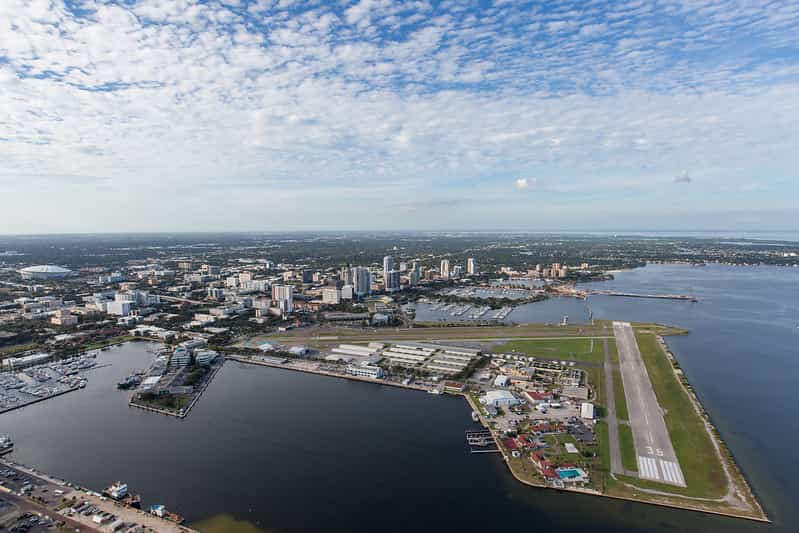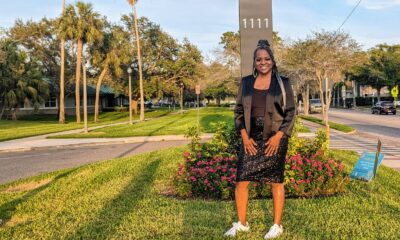Albert Whitted runway extension could pump $400 million into the local economy

St. Petersburg officials expect to complete a new master plan for Albert Whitted Airport by the end of 2020.
A key focus of the plan likely will be a proposal to extend one of the runways further east into Tampa Bay, Rich Lesniak, airport manager, told a City Council committee.
Making that shift could allow the airport’s neighbor, University of South Florida St. Petersburg, and the hospitals and businesses west of USF, to build taller buildings and employ more people in those buildings. That could create a potential economic impact of close to $400 million, according to an economic analysis.
“It’s not very common where an airport looks at doing an improvement like this where you have such a big potential impact off the airport property,” Lesniak said at the Feb. 13 City Council Public Services & Infrastructure Committee.
Albert Whitted Airport, located on 179 acres just south of downtown St. Petersburg, is a general aviation airport with two runways. About 180 aircraft are based at the airport and it averages about 90,000 operations – or takeoffs and landings – in a year.
The last master plan for Albert Whitted was completed in 2007, and the city has since wrapped up most of the projects in that plan. About 85 percent of the $18.5 million in capital improvements from the 2007 master plan were paid for with federal and state grants.
Since then, “there have been a lot of changes in the industry, technology, markets and regulation as well as potential emerging changes that are on the horizon. We hear a lot about autonomous vehicles on the roads. The aviation industry is looking at autonomous air vehicles,” Lesniak said.
In addition, the airport is at full capacity. There are no hangar openings and there are between 70 and 80 names on a waiting list for space.
But one of the most important factors is the extension of the airport’s longest runway, Runway 7/25, Lesniak said.
The runway, like every runway at every airport, has a “runway protection zone” — a trapezoidal area off the end of the runway end designed to protect people and property on the ground in the event an aircraft lands or crashes beyond the runway end.
Runway 7/25’s runway protect zone currently sits on top of USF’s campus. Shifting it to the east, onto airport property, means he runway itself would get extended further east into Tampa Bay.
“That produces a lot of benefits, not just at the airport, but actually off the airport as well. We’re talking safety benefits, operational benefits and economic impact benefits,” Lesniak said. “From a safety standpoint, the airport is safe, but we’re always trying to reduce risk and bring the airport up to the most current standards. Dealing with the runway protection zone is a big part of that.
“Also because we’re having to shift the landing threshold, it’s pushing aircraft to higher air altitudes over USF and the properties west of the campus, so there’s more separation between the ground and the airplane, which is a good thing.
“From an operational enhancement, this type of configuration allows us to have more length, particularly for aircraft departures. This is important because we get a lot of corporate aircraft — jets, multi-engine airplanes — and because we have relatively short runways, a lot of times they can’t take off with a full load of fuel or passengers. This would allow us to reduce or eliminate those restrictions for those aircraft. That would create an economic impact for the airport — more fuel sales, hangar rental demand, job creation.”
The airport would add about 62 jobs, creating an $11.3 million economic impact, according to the economic analysis. Off the airport site, the analysis projects 3,120 new jobs, and a total impact of $381.6 million.
In addition to the extended runway, the city has asked a consulting firm, Environmental Science Associates, to look at additional aircraft storage capacity. Additional hangar space depends, in part, on whether the city decides to keep a waste water plant that occupies almost nine acres on the airport site.
The city held a public forum on the plan last year, and another is likely to be held in late summer or early fall of this year, Lesniak said. There’s also a website where people can submit their ideas for airport improvements and see the plans developed so far.








Lucinda Schartner
February 24, 2020at1:02 pm
No mention of who did economic impact study but by my calculations it means that each of the 62 new employees would each earn and spend $182,000, Also the employees outside the airport would earn or spend $122,000. Wow!! I want one of those jobs.
Ron Ogden
February 18, 2020at10:46 am
Back in the old days, before the Tropi-Dome disaster showed them how ill prepared they were to advocate specific economic developments, the editorial board tried to get the city to shut the airport down as an example of economic injustice.
Brad Banks
February 18, 2020at10:23 am
What will be the economic impact on property values for the residents of Bartlett and Roser Park when much larger , i.e. much noisier planes are taking off and landing over our homes? Nevermind the obvious detriment to our ability to enjoy sitting outside. Will this be a case of one segment of the population paying for the benefit of another? When Logan airport in Boston changed its take-off and landing routes a large segment of homeowners saw their property values plunge and they were unable to sell! And again their quality of life was greatly diminished.
Michael Daley
February 18, 2020at9:18 am
This extension has allready been try years ago and thr feds. Said no
Lee Messina
February 18, 2020at8:59 am
Since a large percent of our clients who buy yachts from us are also pilots, Alfred Whitted airport plays a strong role in boosting our sales because of its unique location in the heart of Downtown & adjacent to one of the largest marinas in Florida. As a St. Petersburg resident & business owner, I applaud the City administrators for thoughtful & progressive economic development such as the runway expansion project.
Sincerely,
Lee Messina, CPYB
Certified Professional Yacht Broker
V.P. & Managing Broker
Professional Yacht Sales International
13205 Gulf Blvd.
Suite B
Madeira Beach, FL 33708
NEIL COSENTINO
February 17, 2020at4:58 pm
We recommended the USF SP KT business school start courses in Commercial Business – Airline and
Airport management programs
Kyle Beamsderfer
February 17, 2020at11:38 pm
Neil, as a USF alum and someone who works in the aviation industry, I 100% agree. I’ll donate to the program and I’d love to teach a course or two.